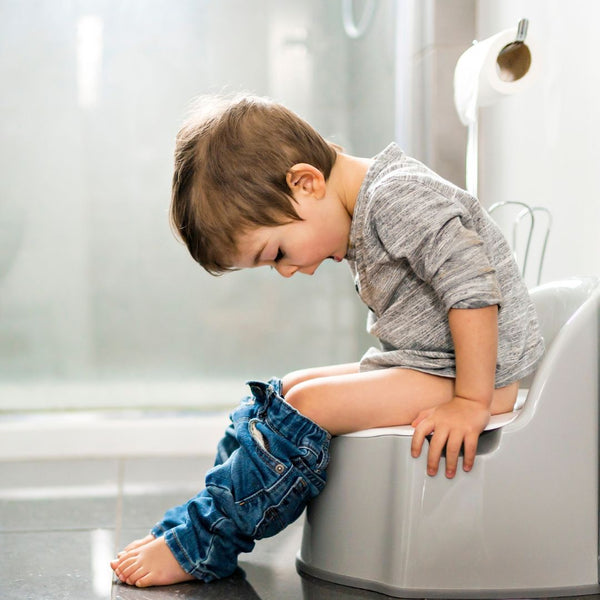A Guide to Potty Training and Baby Elimination Communication
Feb 09, 2023
If you’re like many parents, you are eagerly awaiting the day that you can start toilet training your baby. In the United States, the average potty training age is around 39 months for boys and 35 months for girls. But this is much later than it used to be. In the 1940s, most kids were potty trained by about 18 months. And in some parts of the world, many parents still use an ancient method known as elimination communication to keep their babies largely out of diapers altogether. If you’re eager to say goodbye to diapers, here is what you should know.
Potty Training
For maximum convenience, not to mention sustainability, you’ll want to get your child potty trained as soon as they're ready. But when can you start, and how should you go about it?
The American Academy of Pediatrics says that most kids are ready to start the process at around 18 months of age. Some may be ready a bit sooner, but infants under 12 months old don’t have the bodily control necessary to hold back their waste.
Still, you can start getting your child familiar with the potty process very young. Early potty training tips include talking about bodily functions, getting your child comfortable with a floor-level potty seat, and encouraging practice runs to the potty. Even before your child is fully ready to potty train, following these tips can help to make the connection between the urge to eliminate and using the potty. This will make training easier when the time comes.
Potty training seats come in many different shapes and styles. The first step is a stand-alone potty chair sitting on the floor where the child spends most of their time. Keep the chair in that room at all times, and encourage them to sit on it fully clothed. Use simple, positive language to talk about the chair and its purpose.
When they're comfortable with the chair, start helping them connect it to elimination. Have them sit on it without a diaper in the morning and right after each nap, as well as every two hours or so throughout the day. Dump the contents of their diaper into it, and then into the toilet, and have them flush. Whenever you notice your child showing signs of imminently needing to go, put them on the potty chair.
You can then move the chair into the bathroom, next to the toilet. Keep using positive, factual language to talk about using the potty. When your child is doing a good job of using the potty chair most of the time, switch to a potty seat that attaches to the toilet. You’ll need to add a step stool for your child to climb up as well. Keep doing everything you did with the potty chair, including positive communication and directing your child to the potty whenever they need to go.
If you’re potty training a boy, consider teaching him to urinate sitting down before switching to standing up. Learning to aim is a whole separate skill that takes many boys a bit of time to master.
Potty training can be hit or miss, and it’s normal to get frustrated sometimes. But with patience and active encouragement from their parents, most kids without special needs can fully potty train between the ages of two and three.
Elimination Communication
Based on ancient practices, elimination communication (EC) relies on parents deeply tuning in to their baby’s elimination needs. Also known as natural infant hygiene, the process involves learning the signals your baby gives when they are ready to eliminate and then putting them in an appropriate place to do so. For example, you might hold them over the toilet or another receptacle.
Advocates of EC claim that it soon becomes a two-way street. Parents learn to use positioning and verbal cues to encourage their baby to go, and babies learn to repeat those cues when they’re ready to eliminate. It’s not about teaching babies to hold their waste, which will happen at normal potty training time but simply about creating a back and forth communication that signals that it’s time to go.
EC takes an immense amount of dedication, but many parents find it worthwhile. Your baby won’t need to sit in a dirty diaper or learn to walk with a thick layer of padding between their legs. You won’t need to constantly wash cloth diapers or replace disposable diapers. And many parents find that when the time comes, it’s easier to potty train a child who is used to EC.
Of course, elimination communication won’t completely keep your child out of diapers unless you keep the baby at home and watch them every moment. Most parents find that they still need to use diapers while out and about, as well as overnight. So until your child is fully potty trained, you will likely still need to use some diapers.
And For The Times You Need Diapers
Whether you’re using elimination communication and only need a minimal number of diapers, or you are anxiously awaiting potty training time, DYPER offers a simply kind alternative to traditional disposable diapers. We do offer cloth diapers for parents who prefer them, but diapers made with plant-based materials that are absorbent, soft, and durable, offer the comfort of cloth diapers, along with the convenience of traditional disposable diapers.
For added environmental impact, you can join our add-on REDYPER™ pickup service to send back those dirty diapers using the boxes we provide and return them rather than sending them to a landfill. Join DYPER today and customize your orders, frequency, sizes, and deliveries with our one-tap app and easy-to-manage subscription.




